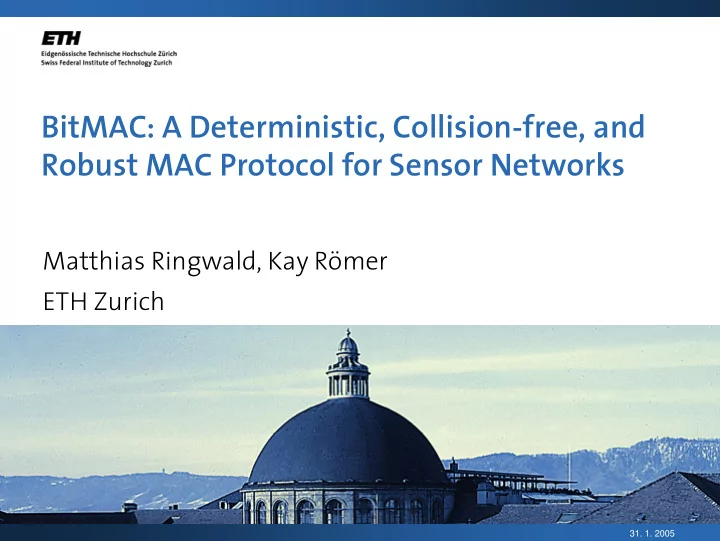

BitMAC: A Deterministic, Collision-free, and Robust MAC Protocol for Sensor Networks Matthias Ringwald, Kay Römer ETH Zurich 31. 1. 2005
Motivation • Dense wireless sensor networks to collect data of physical events • Event causes communication burst • Contention-based MAC protocols => collisions, long delays, reduced bandwidth GOAL: Collision-Free Multi-Hop MAC Protocol 2 31. 1. 2005 Matthias Ringwald, Kay Römer, Institut for Pervasive Computing
Collision-Free Concurrent Access ? Experiment: A 1 0 1 0 0 0 Two nodes A and B send different On-Off-Keying (OOK) B modulated data 1 0 0 0 1 0 Our communication model: A + B ? 1 0 1 0 1 0 The OR channel 3 31. 1. 2005 Matthias Ringwald, Kay Römer, Institut for Pervasive Computing
Integer Operations on Physical Layer • Children synchronously send bits to parent => Bitwise OR • • MAX of in number-of-bits rounds 1 1 0 111 A Side effect: 0 1 1 0 1 0 One child is elected, 1 0 1 0 1 0 if values are distinct 011 101 110 C D E 0 0 0 1 1 1 1 1 1 4 31. 1. 2005 Matthias Ringwald, Kay Römer, Institut for Pervasive Computing
MAX Operation in Parallel • What happens with multiple parents? B 1 0 0 1 1 0 A 1 1 0 0 1 0 0 1 0 1 0 1 1 0 1 1 0 0 0 1 0 0 1 1 0 1 F 100 110 011 101 C D E 1 1 0 1 1 0 1 1 0 1 0 0 Side effect: At most one child elected per two-hop neighborhood, if values are distinct 5 31. 1. 2005 Matthias Ringwald, Kay Römer, Institut for Pervasive Computing
BitMAC: A MAC Protocol using the OR- Channnel • BitMAC builds spanning tree of sensor nodes • without collision • Application assumptions • Network contains sink, e.g., gateway • Data routed mostly from nodes to sink • Network topology mostly static • Nodes can use different radio channels • e.g., TinyDB, directed diffusion, ... 6 31. 1. 2005 Matthias Ringwald, Kay Römer, Institut for Pervasive Computing
Protocol Overview - Setup Phase • Ring formation by synchronous flooding of beacon message with hop count 3 2 1 • OR Channel! • Establish spanning tree Reduce number of uplinks to one by assigning separate radio channels 7 31. 1. 2005 Matthias Ringwald, Kay Römer, Institut for Pervasive Computing
Protocol Overview - Operational • Every inner node with children forms star network • Star networks use TDMA 3 2 1 with single bit send requests • Children need to have small IDs 8 31. 1. 2005 Matthias Ringwald, Kay Römer, Institut for Pervasive Computing
Assigning Channels and Local IDs • Requirements for one ring: • Channels(ch): ch(B) ≠ ch(C) since B and C share child • Local IDs (id): id(A) ≠ id(B) since A and B share parent • Combining both: • Color := Channel = ID • Color (col): col(x) ≠ col(y), if x and y share child or parent Two-hop ring coloring problem 9 31. 1. 2005 Matthias Ringwald, Kay Römer, Institut for Pervasive Computing
Two-Hop Ring Coloring • Nodes maintain palette of free colors 1..C • For C rounds: Parallel MAX Op on MAC Address Every node picks free color from palette • For every color c: • Perform election process within two hop neighborhood If elected, a node assigns color and STOPS • Otherwise, node marks color as used in palette. • • Size of palette for random graphs C = 2 x average-node-degree (with high probability) • see paper for details • 10 31. 1. 2005 Matthias Ringwald, Kay Römer, Institut for Pervasive Computing
Time Synchronization • Synchronization by flooding a sync bit (see ring formation) Receivers lock to the middle • QuickTime™ and a of this bit TIFF (LZW) decompressor are needed to see this picture. Transmissions of multiple • senders overlay due to OR channel • Required precision depends on bit length • network diameter • • See paper for details 11 31. 1. 2005 Matthias Ringwald, Kay Römer, Institut for Pervasive Computing
Status • Prototype implementation of coloring algorithm on BTnodes (only single ring) • Simulation of coloring for larger networks • Open issues: • Bit-synchronous sending in networks with large diameter • Bit errors • Full BitMAC implementation BTnode Rev3 12 31. 1. 2005 Matthias Ringwald, Kay Römer, Institut for Pervasive Computing
Conclusion • “Collisions are not necessarily bad” • Efficient integer operations (OR, AND, MAX, MIN) and election on physical layer • Deterministic and collision-free... • Algorithm for two-hop ring coloring • Spanning tree construction • Multi-hop communication 13 31. 1. 2005 Matthias Ringwald, Kay Römer, Institut for Pervasive Computing
Recommend
More recommend